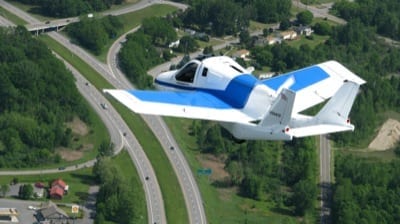The production prototype of the Terrafugia Transition — a flying car — has completed the first phase of its flight test program.
Phase 1 flight testing, conducted at Plattsburgh International Airport in Plattsburgh, N.Y, allowed Terrafugia to check off many critical early testing objectives for the Transition program, said Terrafugia CEO Carl Dietrich, who added, “It’s a real airplane; we’re flying it whenever we want, for as long as we want.”
 Test items accomplished include power on and power off handling, aircraft stability, engine cooling evaluation, and propeller setting optimization in various flight conditions. Five more flight test phases are planned.
Test items accomplished include power on and power off handling, aircraft stability, engine cooling evaluation, and propeller setting optimization in various flight conditions. Five more flight test phases are planned.
The production prototype is now moving into drive testing to explore the ground drivetrain, suspension tuning, braking performance, and road handling, company officials said.
“We have great momentum going in our testing program,” said Terrafugia COO Anna Mracek Dietrich. “Our top priority this summer is flight and drive-testing, in anticipation of certifying compliance with the Light Sport Aircraft (LSA) and National Highway Traffic Safety Administration (NHTSA) standards.”
The Transition was flown by Chief Test Pilot and Director of Flight Test Operations Col. Phil Meteer (US Air Force-Retired). The chase aircraft was flown by Giora Guth.
Terrafugia (terra-FOO-gee-ah), based in Woburn, Mass., is a growing aerospace company founded by pilots and engineers from MIT. The company name is Latin for “escape the earth.”
For more information: Terrafugia.com
People who read this article also read articles on airparks, airshow, airshows, avgas, aviation fuel, aviation news, aircraft owner, avionics, buy a plane, FAA, fly-in, flying, general aviation, learn to fly, pilots, Light-Sport Aircraft, LSA, and Sport Pilot.

My concern would be damage it would sustain from road debris, parking lot “bumper rubs” (i.e. when people don’t quite judge parking space distance correctly, and drag their car’s bumper against your car), and so forth. Imagine someone damaging the wing structure, and the driver-turned-pilot missing it during a pre-flight inspection. They have a good, but impractical, idea.
Seems to me that this is more about proving an “elephant could fly” (white)  and less about a real world market potential. Must say, a group of genius engineers – but WHO, if ever, will really buy it?